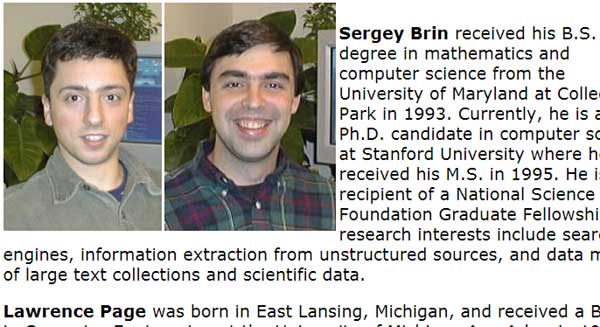NEWS
H1 Headings For SEO – Why They Matter
The use of headings for ranking better on search engines has a long history. It’s one of the earliest known Google ranking factors. Because search engines algorithms evolve, it’s important to understand how why headings remain important and how to use them for modern search engines.
This article links to research papers, patents and statements from Google that shows the best way to use the H1 element for SEO ranking purposes.
Original Google Algorithm and Headings
The original Google algorithm was described in the 1998 “The Anatomy of a Large-Scale Hypertextual Web Search Engine” (available as a PDF research paper and HTML page). That document provided the foundation of Search Engine Optimization (SEO) practices appropriate for modern search engines.
Screenshot of the Anatomy of a Search Engine Paper

The document was widely read by search marketers in the early days and some of the insights remain with us today.
In it is found statements that make it clear that specific kinds of on-page elements were in fact ranking factors.
For example, it states that the title element (title tag) was an important ranking factor. This document from 1998 can be considered responsible for the SEO practice of adding keywords to specific web page elements (headings, title, etc.) for ranking purposes.
Here is an example of how the title tag and the PageRank score was enough to accurately rank a web page:
“For most popular subjects, a simple text matching search that is restricted to web page titles performs admirably when PageRank prioritizes the results.”
Other ranking signals are word position within a document (keywords near the top of the page were more important), font size used, and even capitalization.
The paper describes algorithmically “weighting” the fonts.
That means assigning ranking signal importance to them. When something has more weight, that means it has more importance as a ranking factor.
The founders of Google explained how keyword “hits” (matching query keywords to on-page keywords) were influenced by the “weighting” of various on-page factors and then tallied up as a score.
(IR means Information Retrieval and the IR Score is a measurement of how relevant a page is to a search query.)
This is how the original version of Google’s ranking process is described:
“Google considers each hit to be one of several different types (title, anchor, URL, plain text large font, plain text small font, …), each of which has its own type-weight.
…Google counts the number of hits of each type… Then every count is converted into a count-weight.
Count-weights increase linearly with counts at first but quickly taper off so that more than a certain count will not help. We take the dot product of the vector of count-weights with the vector of type-weights to compute an IR score for the document.
Finally, the IR score is combined with PageRank to give a final rank to the document.”
As you can see, on-page factors were very important, including the size of the fonts. The size of the fonts is a reference to the HTML sizing of the fonts, which is a reference to the headings used and possibly the font size attribute.
By 2003, using the font size HTML attribute was not considered a ranking factor. In terms of ranking factors related to font size, only the heading element (H1, H2, etc.) was considered a ranking factor.
Google Patents Related to Headings
Bill Slawski (@bill_slawski) of GoFishDigital (@gofishdigital), is commonly acknowledged as the leading expert on search engine patents. So I asked him about patents related to heading elements.
Bill responded with two interesting patents.
Screenshot of Bill Slawski speaking with Search Engine Journal
 Bill Slawski speaking with Search Engine Journal
Bill Slawski speaking with Search Engine JournalThe first patent was filed in 2004, which he describes in the article, Google Defines Semantic Closeness as a Ranking Signal
The article explains what the algorithm is trying to do:
“One part of the process behind this approach involves a search engine analyzing the HTML structures on a page, looking for elements such as titles and headings on a page…
In other words, the search engine is attempting to locate and understand visual structures on a page that might be semantically meaningful, such as a list of items associated with a heading.”
Bill explains how the algorithm is figuring out semantic relatedness:
“The patent gives us the following rules about headings and list items when it comes to the distance between words appearing within them:
If both terms appear in the same list item, the terms are considered close to one another;
If one term appears in a list item and the other term appears in the header, this pair of terms may be considered to be approximately equally distant to another pair of terms that appear in the header and another of the list items;
Pairs of terms appearing in different list items may be considered to be farther apart than the pairs of terms falling under 1 and 2.”
Headings and Featured Snippets
Another more recent patent involves the importance of headings in the selection of featured snippets. The algorithm uses the headings on a page as part of the process of selecting passages to be used in a featured snippet.
Bill related that this is what the algorithm is about:
“This answer passages patent uses a page title and main headings to adjust scores for answer passages, by giving them context.”
The article is titled, Adjusting Featured Snippet Answers by Context.
Bill’s article uses the words “heading or headings” 127 times, which shows just how important headings are to this patent.
The article quotes this from the patent, which shows just how important headings were for this patent:
“Receiving a query that is a question query seeking an answer response
Receiving candidate answer passages, each passage made of text selected from a text section subordinate to a heading on a resource, with a corresponding answer score
Determining a hierarchy of headings on a page, with two or more heading levels hierarchically arranged in parent-child relationships, where each heading level has one or more headings, a subheading of a respective heading is a child heading in a parent-child relationship and the respective heading is a parent heading in that relationship, and the heading hierarchy includes a root level corresponding to a root heading (for each candidate answer passage)
Determining a heading vector describing a path in the hierarchy of headings from the root heading to the respective heading to which the candidate answer passage is subordinate, determining a context score based, at least in part, on the heading vector, adjusting the answer score of the candidate answer passage at least in part by the context score to form an adjusted answer score.”
What Google Says About H1 and Headings in General
Google’s John Mueller has fielded many questions about headings. The reason why there’s so much interest is because headings continue to be perceived by the SEO community as having more weighting, a higher level of influence as a ranking factor.
Algorithms Evolve
While the heading element may have had a stronger weight as a ranking factor in the past, that influence may have evolved.
Bill Slawski’s example about how headings might be used in the process of selecting featured snippets is an example on how the influence of heading elements has evolved.
In the featured snippets patent, the heading elements are used for understanding context. They are not used to give more ranking power to a passage of content.
In other words, instead of influencing a ranking score, the headings are being used to influence how an algorithm understands what a passage of content is about.
Statements by Google’s John Mueller on H1 Headings
That patent aligns with the most recent statements that Google’s John Mueller has made about H1 headings and headings in general.
Screenshot of John Mueller Explaining How Google Uses H1 Headings for Search

John Mueller Discusses How to Use Headings
Search Engine Journal published an article titled, John Mueller on How to Use Headings. The article notes Mueller’s answer on how to use headings for SEO.
John confirmed that Google still uses headings for search. He said that Google uses them to understand content.
“We do use headings when it comes to search. But we use them to better understand the content on the pages.”
H1 Headings and Order of Headings
In what may be shocking to some in the SEO industry, Mueller asserted that the order of the headings doesn’t matter to Google.
According to Mueller, the importance of the heading elements is to communicate what the following text passage or image is about.
How Mueller explained heading elements:
“So… this question of… how should I order my H1, H2, H3, headings and what should the content be, that’s something from my point of view isn’t really that relevant.
But rather, what we use these headings for is well we have this big chunk of text or we have this big image and there’s a heading above that, therefore maybe this heading applies to this chunk of text or to this image.
So it’s not so much like there are five keywords in these headings, therefore this page will rank for these keywords but more, here’s some more information about that piece of text or about that image on that page.
And that helps us to better understand how to… frame that piece of text, how to frame the images that you have within those blocks. And with that it’s a lot easier to find… the right queries that lead us to these pages.
So it’s not so much that suddenly your page ranks higher because you have those keywords there.
But suddenly it’s more well, Google understands my content a little bit better and therefore it can send users who are explicitly looking for my content a little bit more towards my page.”
Google and Using Multiple H1 Elements
John Mueller has discussed the use of multiple H1 elements. In the past it was understood that the H1 element sent a more powerful signal than an H2 element.
Some in the SEO industry may reason that if the H1 element is stronger than an H2, H3 element, that using H1 elements through a web page may send a stronger keyword signal. But that is incorrect, that’s not how ranking works.
As we can see from Mueller’s comment above and even in the Google patent that Bill Slawski wrote about, that is no longer be the case.
John Mueller recently dispelled all doubts about this point when he debunked the strategy of using multiple H1 elements for ranking purposes.
This point about using multiple H1 elements was documented in an article titled, John Mueller on Multiple Use of H1 Headings.
Mueller explained:
“You can use H1 tags as often as you want on a page. There’s no limit, neither upper or lower bound.
Your site is going to rank perfectly fine with no H1 tags or with five H1 tags.”
Heading Elements Give Structure to a Page
Mueller next reiterated the importance of heading elements as a way to give structure to a web page.
“H1 elements are a great way to give more structure to a page so that users and search engines can understand which parts of a page are kind of under different headings.
So I would use them in the proper way on a page. And especially with HTML5 having multiple H1 elements on a page is completely normal and kind of expected.
Some SEO tools flag this as an issue and say like Oh you don’t have any H1 tag or you have two H1 tags… from our point of view that’s not a critical issue.”
Heading Tags Continue to be Important
In the answer documented above, Mueller said that a web page can rank without the use of headings. This is true.
But that does not diminish the importance of the use of headings in a web page. Headings continue to be a useful way to make it clear what a web page is about.
The importance of heading tags was documented in the article titled, Heading Tags are a Strong Signal
Google’s Mueller explained why headings are important:
“So, headings on a page help us to better understand the content on the page.
Headings on the page are not the only ranking factor that we have.
We look at the content on its own as well.
But sometimes having a clear heading on a page gives us a little bit more information on what that section is about.”
Headings For Image SEO
Mueller also discussed how the textual context of headings helps Google to understand what images are about.
“So in particular when it comes to images, that’s something where headings and the context of that image helps us a lot to understand where we should be showing that image in search.
…images are not text. We don’t automatically know what we should be showing it for.
And that combination of the image plus the landing page is something that depends quite a bit on the text of the page.”
Headings are a Strong Signal
Mueller next reaffirmed that headings are a strong signal.
“And when it comes to text on a page, a heading is a really strong signal telling us this part of the page is about this topic.
…whether you put that into an H1 tag or an H2 tag or H5 or whatever, that doesn’t matter so much.
But rather kind of this general signal that you give us that says… this part of the page is about this topic. And this other part of the page is maybe about a different topic.”
Headings Communicate Semantic Meaning
The original Google algorithm research paper from 1998 demonstrates without question that text reproduced in larger fonts were interpreted as being important for ranking purposes. More recently, patents that mention heading elements discuss them as a way for understanding context and not so much for generating a ranking score.
A further indication of the evolution of how headings are used come from statements by Google’s John Mueller that indicate that the way heading tags are used may have indeed changed since 1998.
Heading tags continue to be important. But because Google’s algorithm has changed in the past twenty two years, it may be useful to pay close attention to what Google’s patents and Googlers have to say about headings and update one’s search strategy accordingly.
















